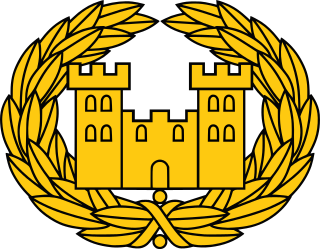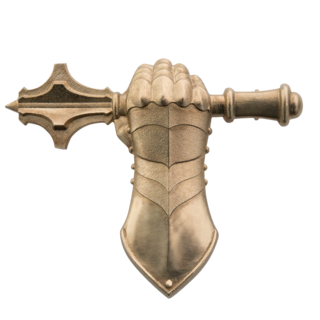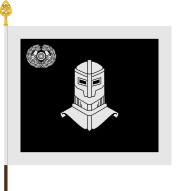
The Patria Pasi is a Finnish-made six-wheeled armoured personnel carrier (APC) originally designed for Finnish Defence Forces. The first variant was produced in 1983 and serial production began in 1984. It was designed to operate with ease of use, simple structure and low-cost maintenance. The basic appearance and configuration of the Pasi is similar to most other wheeled APCs. The XA-180 and XA-185 are fully amphibious while other variants are not.
The Helsinki Air Defence Regiment is unit of the Armoured Brigade in Parola. The regiment was previously an independent Finnish Army unit located in Hyrylä. The regiment trained 800 conscripts per year.

Kainuu brigade is a Finnish Army unit situated in Kajaani. The brigade is one of the biggest army units, training approximately 4000 conscripts annually. The Kainuu Brigade is one of the three readiness brigades in the Finnish Army. The brigade trains troops for war-time Kainuu Jäger Brigade.
The Military ranks of Finland are the military insignia used by the Finnish Defence Forces. The ranks incorporates features from Swedish, German, and Russian armed forces. In addition, the system has some typically Finnish characteristics that are mostly due to the personnel structure of the Finnish Defence Forces. The ranks have official names in Finnish and Swedish languages and official English translations. The Swedish forms are used in all Swedish-languages communications in Finland, e.g. in Swedish-speaking units of Finnish Defence Force. The system of ranks in the Swedish Armed Forces is slightly different.

The Danish Division, short DDIV, is the only remaining military land division in Denmark. It was created on 1 January 1997 as the successor of Jutland Division. It is one of the now-three Divisions of Multinational Corps North East, the German-Danish-Polish Corps, the successor to the former German-Danish Allied Land Forces Schleswig-Holstein and Jutland (LANDJUT), a NATO Allied Forces Northern Europe formation.

The Hungarian Ground Forces constitute the land branch of the Hungarian Defence Forces, responsible for ground activities and troops, including artillery, tanks, Armoured Personnel Carriers (APCs), Infantry Fighting Vehicles (IFVs), and ground support. The ground forces have a history of service in Iraq and are currently engaged in the KFOR operation.

The Ukrainian Ground Forces, also referred to as the Ukrainian army, are the land forces of Ukraine and one of the eight branches of the Armed Forces of Ukraine. They were formed from Ukrainian units of the Soviet Army after Ukrainian independence, and trace their ancestry to the 1917–22 army of the Ukrainian People's Republic.

The Bulgarian Land Forces are the ground warfare branch of the Bulgarian Armed Forces. It is administered by the Ministry of Defence, previously known as the Ministry of War during the Kingdom of Bulgaria. The Land Forces were established in 1878, when they were composed of anti-Ottoman militia (opalchentsi) and were the only branch of the Bulgarian military.
List of abbreviations, acronyms and initials related to military subjects such as modern armour, artillery, infantry, and weapons, along with their definitions.

The Ukrainian Marine Corps, also known simply as the Ukrainian Marines, is the maritime land force service branch of the Armed Forces of Ukraine since 2023, responsible for conducting expeditionary and amphibious operations. From its modern foundation in 1993 up to 2023 it constituted part of the Coastal Forces of the Ukrainian Navy. It is used as a component part of amphibious, airborne and amphibious-airborne operations, alone or in coordination with formations and units of the Ground Forces in order to capture parts of the seashore, islands, ports, fleet bases, coast airfields and other coast objects from the enemy. It can also be used to defend naval bases, vital shoreline areas, separate islands and coast objects, and security of hostile areas.
The Balkan Front was a military formation of the Bulgarian People's Army, intended for wartime use under the general direction of the Soviet General Staff. If a war was to have broken out between NATO and the Warsaw Pact, the bulk of the Bulgarian army would have been assigned to it.

Mechanized Infantry Forces of Ukraine are the general basis and primary combat formations of the Ukrainian Ground Forces. They execute tasks of holding the occupied areas, lines and positions tasks of enemy's impacts repelling, of penetrating the enemy's defense lines, defeating the enemy forces, capturing the important areas, lines and objectives, and can operate in structure of marine and landing troops.
The Patria Pasi is a military armoured personnel carrier. It was the choice of the Finnish Defence Forces to replace its aging Soviet BTR-60s. It was a result of the commercial competition between two Finnish companies, a tractor manufacturer Valmet and the lorry manufacturer Sisu, which won the contract with its prototype.
This article provides formation lists of the Polish People's Army order of battle at various points in history between 1943 and 1989.
The Northern Army Group (NORTHAG) was a NATO military formation comprising five Army Corps from five NATO member nations. During the Cold War NORTHAG was NATO's forward defence in the Northern half of the Federal Republic of Germany (FRG). The Southern half of the Federal Republic of Germany was to be defended by the four Army Corps of NATO's Central Army Group (CENTAG). During wartime NORTHAG would command four frontline corps and one reserve corps. Air support was provided by Second Allied Tactical Air Force.

The Czech Land Forces are the land warfare forces of the Czech Republic. The Land Forces consisting of various types of arms and services complemented by air and special operations forces constitute the core of the Czech Armed Forces. Land Forces Command is located in Olomouc.
The full structure of the Polish Land Forces is:

Enhanced Forward Presence (EFP) is a NATO-allied forward-deployed defense and deterrence military force in Northern, Central and Eastern Europe. This posture in Northern Europe through Estonia, Latvia, and Lithuania and in Central Europe through Poland, Slovakia and Hungary and in Eastern Europe through Romania and Bulgaria, is in place to protect and reassure the security of NATO's Northern, Central and Eastern European member states on NATO's eastern flank.

The Armoured Troops are the armored corps of the Ukrainian Ground Forces, the main striking force of ground troops. They are used primarily in conjunction with mechanized forces in key areas and perform the following tasks:
The following is a hierarchical outline of the Czechoslovak People's Army at the end of the Cold War. It is intended to convey the connections and relationships between units and formations. At the end of the Cold War in 1989 the Czechoslovak People's Army structure was as follows.













